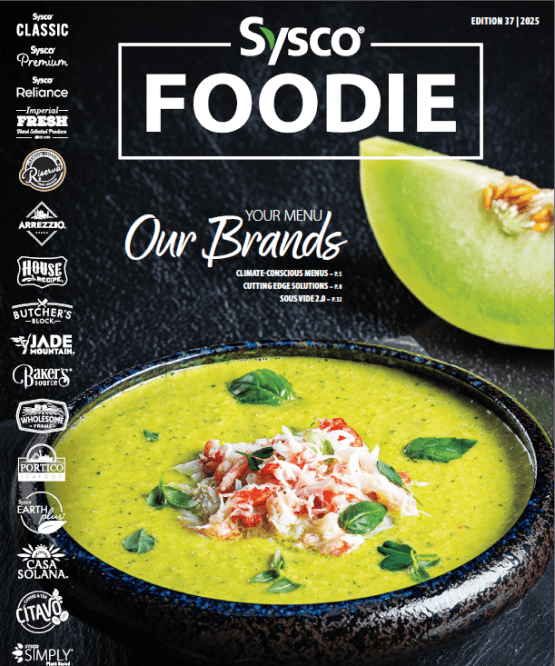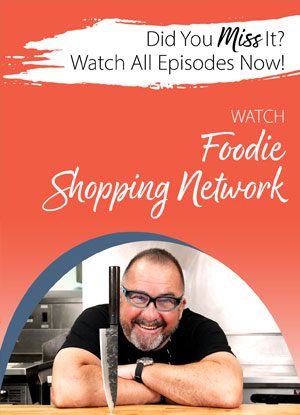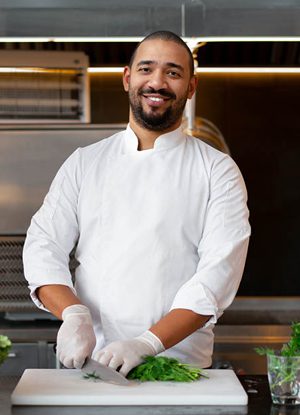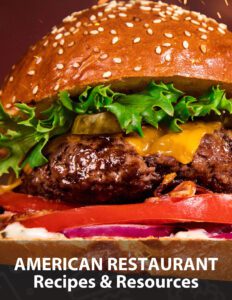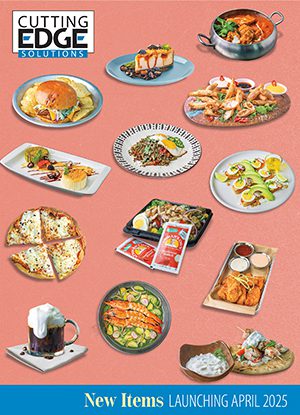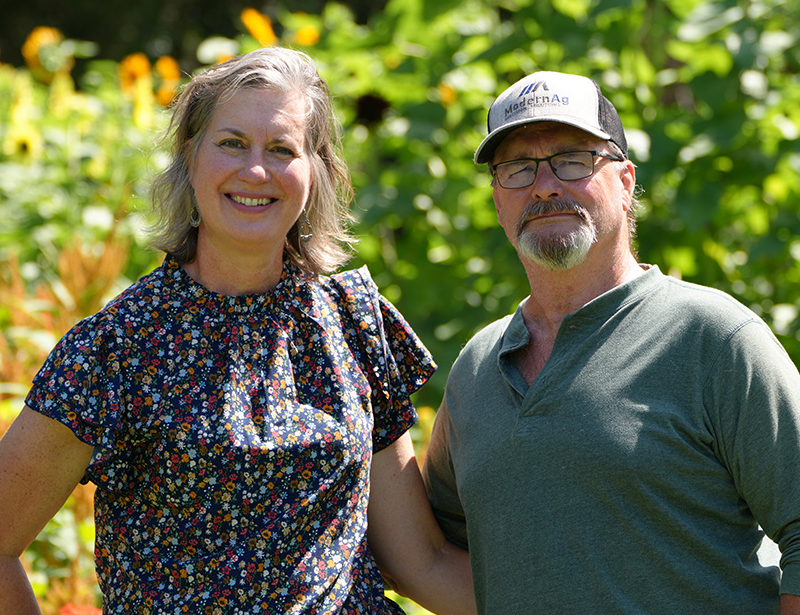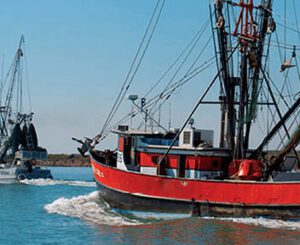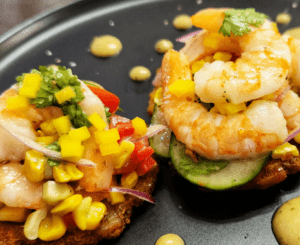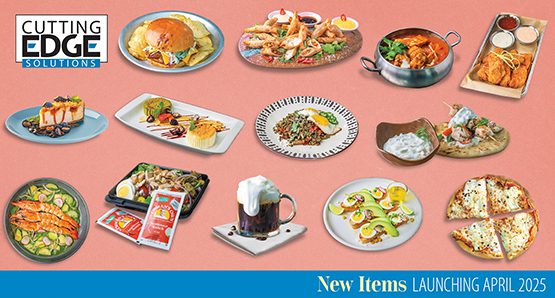The Business of Beef
In the sleepy town of Norwich, Kansas, population 444, the morning sun slowly rises behind a big red barn, casting a golden glow on the 40 acres of lush green pastures of VB Bar Ranch. Several red Angus cows and their calves slowly start grazing the grasses, taking advantage of the cool stillness of morning before the summer heat forces them to seek shade. It’s a peaceful, almost idyllic vista that looks like an ad for Farm & Ranch Magazine. Now, let’s pivot to your reality. Your dish machine just broke down, your line cook called in sick, and you still need to finish out next week’s schedule. All you can picture right now is where that big bottle of aspirin is for the gigantic headache that’s forming in your head. That ranch image we just conjured up? Yeah, that’s pretty much the last thing you would ever envision as your Sysco driver starts stacking cases of Fire River Farms burgers, Butcher’s Block Reserve Angus strip loins and ribeye into your cooler.
But wait, let’s take a minute. This is important. Why? In today’s world, environmental, social, and cultural issues are changing the landscape of how diners think about food and how they make choices of where to dine out. We’ve all heard the buzz words – food waste, sustainability, farm to table dining, locally sourced. Consumers are becoming increasingly more conscious of where their food comes from and they want to know how it was sourced. When asked, most servers would probably say, “I don’t know. But I can check with the chef”, or better yet, “Oh, we get our meat from Sysco”. Sigh… But we’re here to tell the story and map the journey. The more educated your entire staff, both back and front of house team members, not only the greater appreciation and understanding they’ll have for the product itself, but the more pride they’ll have that your operation embraces the strong values our society is promoting.
It all starts with the ranchers, their livelihood, land, and love of beef.
The largest real-life ranch in America is King Ranch, which consists of a whopping 825,000 acres of land and is home to over 35,000 cattle. And, according to the USDA, the typical herd of beef cattle is only 50 animals. Cargill, one of Sysco’s trusted partners for beef products, sources from a network of hundreds of thousands of ranchers, most with less than 100 head of cattle, which serve as the first stage of the beef supply chain. Family farms and ranches are frequently described as the backbone of the nation. Since the family is tied to the land, they also have a vested interest in the well-being of their animals, in the economic vibrancy of their community, and are natural stewards of the earth and its resources.
One of the family farms in Cargill’s US beef supply chain is VB Bar Ranch, owned by Vonda Behrens and her husband Bryan. They are a cow-calf operation that raises Red Angus Cattle and their typical herd size is 20 animals. Although Vonda was raised in Nebraska, her father and grandfather were big fans of raising cattle, and she got her first heifer when she was only eight years old. Growing up with cattle and crops on the Nebraska family farm she became a member of the local 4-H club, showing cattle and learning about raising beef. After high school she studied animal science in college with an emphasis on production and meat science. Bryan came from agricultural roots as well, and when they met and eventually married, they both knew they wanted to build a life and raise a family on a ranch. Whether they had one head, or up to 30 head, the impact of leadership, the importance of chores, and the appreciation for the cycle of life were lessons they could pass on to their children and the younger generation of their community.
Not only was Vonda practically “born” to raise beef, but her passion to help get more beef on people’s plates led her to begin working for Cargill and selling beef as well. Upon graduating college, Vonda began her career with Cargill and has now been with the company for 35 years. As part of the Sysco Trade Sales team, Vonda manages all boxed beef that is ordered across all the Sysco operating sites. She has extensive knowledge of market trends, pricing, specific cuts, and what’s going on in the industry. In her role at Cargill, Vonda has been able to gain deep insights into exactly what operators and producers want and what they’re looking for in their beef products. As a cow-calf operation, Vonda is literally at the very beginning of the food chain. A certified breeder with extensive animal husbandry training and experience in beef cattle genetics, Vonda works with trusted partners and artificially inseminates her “mama cows” to put less strain and stress on the animals. “Bred from scratch”, these animals have the perfect DNA Vonda needs, and will mature into healthier cattle with traits that are more desirable for muscle mass and marbling, qualities that producers, foodservice operators and consumers are looking for. But it takes more than just good genetics to develop a great product. Vonda has a fully hands-on approach to her cattle and carefully monitors and makes sure each one is taken care of. The Behrens rise early each morning and immediately head out to check on the herd. It’s a 24/7 job, and the animals always come first. Before they even have breakfast themselves, Vonda and Bryan are making sure the cows and calves are fed, that they have fresh water, flies have been kept at bay, and the herd appears overall happy and healthy. The cattle graze the land and consume a natural diet, but their nutrition is also supplemented with hay and grain. Because the cattle feed on so much grass, Vonda and Bryan have a deep respect for the land and work hard to maintain it. While they need to rely on Mother Nature and good ol’ rain to provide the moisture in the grasses, keeping the weeds controlled, managing flies and mending fences are just a few of the day in the life responsibilities at the ranch.
Vonda’s passion for ranching is not financially motivated, rather it is driven by her love of nature and the nurturing aspect of taking care of animals. She’ll tell you about the experience of watching a cow labor and deliver her baby calf with such emotion and joy you can’t help but get caught up in the wonder of it all. With equal passion, she’ll also talk about working outside in freezing temperatures, in the dark of night, to administer aid to a young calf in a frantic effort to save it. These are not just animals to Vonda and Bryan, these cattle are an extension of their family. Fun fact, Vonda even names all of her calves. Each year has a theme, and this year it was flowers. One of the youngest, newest members of the cattle family is Rose.
Raising Beef to a Higher Standard
You’ll hear a lot of conversation about “sustainability” and while many talk the talk, they don’t always walk the walk. While numerous definitions of sustainability abound, one of the best ways to sum it up is it’s the ability to exist and develop without depleting natural resources for the future. Vonda and her family have a deep appreciation for the land and are dedicated to caring for the resources entrusted to them. Grazing cattle on the land helps keep carbon locked in the soil, recycles nutrients, and provides habitats where wildlife can thrive. In a broader sense, family farms also sustain their very communities. Even in a small town such as Norwich, VB Bar Ranch helps bolster the local economy through the purchase of supplies and materials through small businesses and hiring local workers. Their farmstead has deep roots in ranching, having been homesteaded back in 1880 and even evidenced with a 1912 date emblazoned on their stock tank. Applying best practices and ranching responsibly, the Behrens pride themselves on their commitment to keep this legacy for generations to come.
Looking towards the future, ask Vonda what some of the biggest challenges are facing the industry today and you might be surprised by the answer. Yes, there are the higher costs for feed, medicine, and vitamins to keep cattle healthy. Labor and farm equipment come with steeper prices as well. And higher interest rates to purchase land can make it hard to break into this industry if you haven’t inherited a property. With all these headwinds, no one would be surprised if existing and would-be ranchers just decided to hang up their hats for good. But for families like Vonda’s, there’s way too much heart and soul invested to make them turn their backs on the livelihood they love. So, what is their greatest concern? For many family-owned ranches, it’s the aging rancher and succession planning. According to the USDA, the average age of a farmer/rancher in the US is 57.5 years. A lot of younger people would love to get into farming and do it full time, but as mentioned earlier, it can be too expensive to get into it. Some of the larger farms need help, but it can be hard to compete with factory jobs that offer better pay, health insurance, and benefits. Vonda and her husband have always been committed to giving back and tirelessly volunteer with organizations such as Future Farmers of America and local 4-H clubs to help educate and build youth leaders in the agriculture space. Here at Sysco, we’re proud to be an official supplier for the Houston Livestock Show and Rodeo, the world’s largest livestock show and family friendly experience that facilitates better agricultural practices and provides year-round educational support to Texas youth. We all want to see the legacy of family farms continue, and for that to happen, it’s imperative to get the attention of youth and keep them interested in farming and agriculture. The good news is despite the obstacles, statistics are starting to show that there has been a higher interest in agriculture among the younger generation within the last few years.
Another challenge according to Vonda is simply the lack of understanding and appreciation for the level of dedication and investment of physical, financial, and emotional resources that go into breeding and raising cattle. Expenses are tied up in ranching and ranchers don’t recoup their costs until after the animal is sold. Diners may relish that juicy hamburger they ordered from their local burger joint, or delight in a perfectly seared ribeye on a plate at their favorite steakhouse, but they just don’t think that much of it. Your servers and back of the house staff probably have a similar attitude. They may have no idea where the beef came from, and everything that went into bringing that burger or steak from farm to table, and the extreme pride ranchers take in doing what they do. Times are a-changin’, though, and today’s consumer craves transparency and there is more of a desire to know where their food comes from. We want to educate and empower all parties, at both the operator level and at a consumer level, and foster a feeling of humility, gratitude, and respect towards food. Through these supplier stories and this type of storytelling, we feel we can.
Vonda’s ranch and her story is just one of many in the Cargill family of suppliers. These ranchers have a level of passion and dedication to their cattle that ultimately results in the high quality and performance of our beef that you can see and taste. You can serve with confidence knowing that our beef comes from a trusted partner with higher standards to ensure a great tasting product every time.


